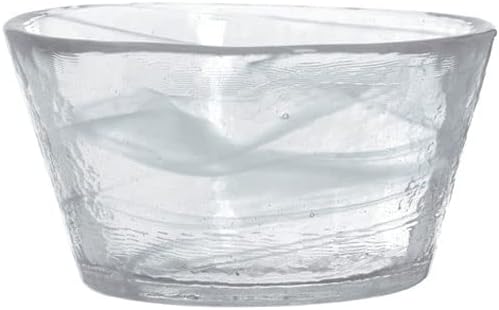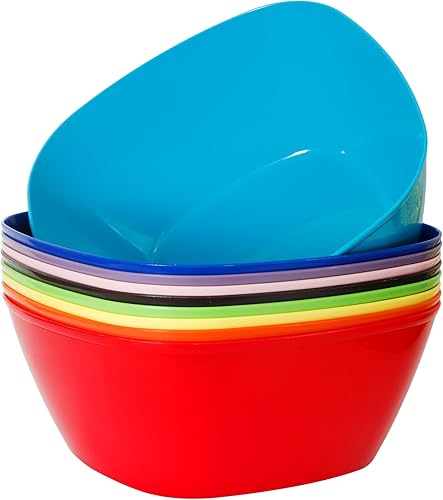Kosta Boda Mine - Cuenco decorativo blanco, 5.25" X 2.75"
Categoría: Tazones para Servir
Precio y disponibilidad de Kosta Boda Mine - Cuenco decorativo blanco, 5.25" X 2.75"
Q 711.69
Q 790.77
Entrega estimada de 6 a 10 dias habiles en Guatemala.
 -10%
-10%
Categoría: Tazones para Servir
Q 711.69
Q 790.77
Entrega estimada de 6 a 10 dias habiles en Guatemala.
Reseña del editor La mía es una de las series más populares de Kosta Boda que comprende cuencos, jarrones, platos y vasos. Los colores flotan mágicamente dentro del grueso vidrio como una cortina de humo, haciendo que cada pieza sea única. Cada artículo tiene el sello distintivo de Ulrica Hydman Vallien en la base. Tienda Famous for her expressive and energetic work, artist Ulrica Hydman-Vallien designed the Mine line for Kosta Boda with free-flowing color and organic shaping. The collection--a blend of bowls, dishes, and tumblers--is at once bold and subtle, with richly layered veils of a single hue in each piece. Subtle ribbing, polished rims, and simple flared silhouettes complete the design. The colors throughout the collection offer a striking complement to one another or stand alone with confidence. Handcrafted in Sweden, each Mine edition is distinctive in its details. Suitable for display as well as function, this substantial little bowl features beautiful wisps and swirls of color against a clear background. The thick sides and flat bottom create a handsome, artisanal quality. Completely lead-free, the bowl measures 5-3/8 inches in diameter and stands 2-3/4 inches high. It should be washed by hand for best results. --Emily BedardFrom the ManufacturerAbout the Designer Born in 1939, Ulrica Hydman-Vallien has been on retainer at Kosta Boda since 1972. One of Swedens best known and most popular artists, she creates unmistakable figures that can be seen on Ericsson mobile phones and the tails of British Airways airplanes, among other places. Hydman-Valliens most important form of expression, however, is through her glass designs, which also played a large part in Kosta Bodas success in the 1980s and 1990s. "For me," she explains, "glass must always be close to your hand, to your innermost feelings, to your heart." Working with free and unrestrained energy, Hydman-Vallien paints her striking and humorous designs straight onto the glass. Her distinctive female faces, tulips, and snakes have decorated big-selling classics such as Open Minds, Tulipa, and Caramba. Her work is also exhibited in museums and collections all over the world. About Kosta Boda With characteristic craftsmanship and good design, Kosta Boda has become one of the leading glasshouses in the world. The company's three glassworks in the villages of Kosta, Boda, and Åfors each have exciting individual stories of their own yet stand together under the common brand name Kosta Boda. The corps of designers currently on retainer at Kosta Boda works with both utilitarian and art glass. Glass results from a great many meetings between people--artists, craftspeople, and lovers of glass. The artists of Kosta Boda have a decisive role to play in all the creative stages of the process. The cooperation between the designers and the skilled craftspeople is very close; indeed, it is essential if the designers are to transfer their intentions to the glass. The History of Kosta Boda Kosta, the parent glassworks of Kosta Boda and the oldest glassworks in Sweden still in operation, has a fascinating history that forms a valuable part of Swedish cultural heritage. The glassworks was founded in 1742 by the governors of the counties of Kronoberg and Kalmar, Anders Koskull and Georg Bogislaus Stael von Holstein, both former generals in the army of Karl XII and distinguished veterans of the battle of Narva, among others. The two county governors founded the glassworks upon the instructions of Fredrik I and modeled it on Continental glassworks. The works was situated deep in the spruce forests of Småland, on a site midway between the two country towns, and near a village that was then known as Dåfvedshult. The main reason for choosing this location was the unlimited availability of wood. Enormous quantities of wood were naturally required to keep the glassmaking furnaces burning day and night. Both of the founders wanted their names to be remembered, so the works was christened Kosta, from the initial letters--Ko and Sta--of the surnames of both the Carolinian generals. After a time the entire community was renamed after the growing glassworks. During the first 150 years, the glassworks in Kosta produced only utility glass, including window glass for the building of Tessin's Royal Palace, bottles and glass for the royal household, and chandeliers for churches. The first glassblowers were immigrant glass masters from Böhmen. They became the founding fathers of the glassblowing families, which passed down craft skills from generation to generation. Swedish sand was used to manufacture crystal glass, but nowadays pure silica sand is imported from Belgium, since the Swedish sand contains iron oxide that gives the glass a green tinge. Under the management of glass masters from Kosta, a succession of glassworks sprang up in the forests of Småland in the regions around Växjö and Kalmar. Kosta therefore has good reason to call itself the parent works of the entire Swedish Kingdom of Crystal. Until the end of the 19th century, the glass from Kosta was designed by the glassblowers themselves. At the Stockholm exhibition in 1897, the glassworks was criticized for the uniformity of its glass, which led to the idea of enlisting designers and artists in production. The first designer to be employed by Kosta was Gunnar Wennerberg. The year was 1898. Ever since then a large number of artists and designers have enriched the glassmaking tradition of the works with their artistic talents. Today Kosta Boda has a unique right to describe itself as an art industry, in which designers and craftspeople work closely together in the ongoing development of handmade utility glass and art glass. This diversity of individual artistic expression and the free and uninhibited creative process have become the distinguishing characteristics of the Kosta Boda brand. In addition to the parent works in Kosta, Kosta Boda today includes the two "daughter works" of Boda (founded in 1864) and Åfors (founded in 1876), a partnership that was formed in 1964. Both Boda and Åfors were originally relatively simple glassworks that manufactured utility glass. Boda experienced a period of glory in the 1960s and 1970s, under the innovative and dynamic artistic leadership of Erik Höglund, a heritage carried on by Kjell Engman and Monica Backström. Åfors has been the home of the designer couple Ulrica Hydman-Vallien and Bertil Vallien, who, together with Gunnel Sahlin and Olle Brozén, brought a renaissance to the small glassworks and local community. In 1990 Kosta was acquired by its former competitor Orrefors. Orrefors/Kosta Boda was in turn acquired by the Danish company Royal Copenhagen in 1997, and the design group Royal Scandinavia was formed. The group also includes Georg Jensen, Royal Copenhagen, and Holmegaard. Colorful, handmade art glass from the works in Kosta, Boda, and Åfors have made Kosta Boda one of Sweden's strongest brands and one of the world's leading glass companies. Glass from Kosta Boda is sold all over the world. Roughly 50 percent of production is sold outside Scandinavia, with some of the biggest markets in the U.S., Japan, Germany, and Australia. The origins of this glass, the living tradition of craftsmanship developed in the glassworks in Kosta, Boda, and Åfors, is a heritage that every Swede has a right to feel proud of. Taking Care of Kosta Boda Pieces Handmade and hand-painted glass (especially the latter) does not do well in the dishwasher. Wash by hand in hot water--though not too hot--with a little washing-up liquid. Washing in very hot water will eventually destroy the luster of the glass. Rinse in water of about the same temperature as you washed it in. To avoid cracking the glass, make sure you do not expose it to excessive temperature differences. To avoid lines, dry with a soft cloth that won't shed lint. The edge of the glass is its most fragile part. When you put the glass back in the cupboard, stand it on its foot and make sure the edge does not come into contact with other glasses or objects. The Mark or Signature on Kosta Boda Pieces Products are marked with the words Kosta Boda, the name of the artist, and the article number (seven digits). Painted pieces are signed with a painted signature with the designer's and the painter's initials. Engraved pieces also have the engraver's signature near the designer's name. Besides designing glass for the regular Kosta Boda collection, our artists are also free to work with art glass--limited-edition, specially signed pieces that are often much sought after by collectors. Kosta Boda art glass is divided into two categories: unique pieces and limited editions. Unique pieces are, of course, just that. No more than one piece is made of any particular item. Limited editions are manufactured in runs of between 25 and 1,000 pieces. All art glass is marked with the product number, the name of the artist, and the size of the edition so that the purchaser will know exactly how many pieces there are in that particular series. Editions comprising less than 60 pieces are individually numbered, e.g. "25/60."
Envíos a todo el país
Cobertura nacional con aliados confiables.
Garantía Yaxa
Productos originales y respaldo local.
Pagos seguros certificados
Procesamos tus pagos con pasarelas auditadas.

Now Designs Vajilla con forma de plato, 7.2 pulgadas de ancho x 4 pulgadas de largo, champiñones de campo
Q 260.75
Envío gratis

Plato de cerámica antiadherente en forma de calabaza Mini tazón con asas y tapa Ollas de vajilla modernas y creativas para servir, cocinar y
Q 298.15
Envío gratis

MARA STONEWARE COLLECTION - Plato de mantequilla cubierto coleccionable, cerámica mexicana, diseño de sol del desierto
Q 553.15
Envío gratis

Golden Rabbit Enamelware - Cuenco de catering de 5 cuartos de galón (remolino del sol)
Q 731.65
Envío gratis

Yair Emanuel - Cuenco de vidrio para servir miel para Shabat y Rosh Hashanah, soporte de granada de metal (azul HDC-4C)
Q 236.1
Envío gratis

Elegance Bandeja de mariposa cuadrada para servir, 10.5 pulgadas, platadorado
Q 878.7
Envío gratis

Youngever Paquete de 9 cuencos de plástico para mezclar y servir de 120 onzas, cuencos cuadrados para palomitas de maíz, ensaladeras, cuencos para
Q 451.15
Envío gratis

Melamina Salsa Plato
Q 1,169.4
Envío gratis